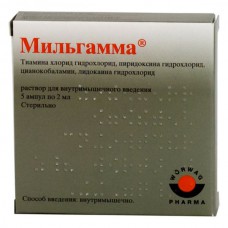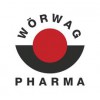Expiration date: 10/2026
Pharmachologic effect
Mode of action - metabolic, neuroprotective, analgesic
Pharmacodynamics
Neurotropic B vitamins have a beneficial effect on inflammatory and degenerative diseases of the nerves and the skeletal system. Thiamine plays a key role in the metabolism of carbohydrates, and in the Krebs cycle with subsequent participation in the synthesis of thiamine pyrophosphate and ATP. Pyridoxine is involved in protein metabolism and partially - in the metabolism of carbohydrates and fats. The physiological function of both vitamins is a potentiation of each other, which manifests itself in a positive effect on the nervous and neuromuscular systems. Cyanocobalamin is involved in the synthesis of the myelin sheath, reduces pain associated with a lesion of the peripheral nervous system stimulates nucleic exchange via folate activation. Lidocaine - local anesthetic, causing all kinds of local anesthesia: terminal, infiltration, and conductors.
Pharmacokinetics
After the / m of thiamine is rapidly absorbed from the injection site and enters the blood (484 ng / ml after 15 minutes on the first day of dosing with 50 mg) and unevenly distributed in the body when its content in leukocytes - 15% red blood cells - 75% and plasma - 10%. In the absence of significant reserves in the body of vitamin, it must be ingested daily. Thiamine penetrates the blood-brain and placental barriers and is found in breast milk. Thiamine is excreted in the urine through the alpha phase 0,15 h in the beta phase - after 1 h, and in the terminal phase - for 2 days. The major metabolites are tiaminkarbonovaya acid Pyramin and some unidentified metabolites. Of all the vitamins thiamine stored in the body in the smallest amounts. An adult human contains about 30 mg of thiamine as thiamine pyrophosphate in (80%), thiamine triphosphate (10%) and the remainder in the form of thiamine monophosphate.
After intramuscular injection of pyridoxine is rapidly absorbed into the bloodstream and distributed in the body, acting as a coenzyme after phosphorylation CH2OH group in the 5th position. About 80% of vitamin binds to plasma proteins. Pyridoxine is distributed throughout the body, crosses the placenta and is found in breast milk, it is deposited in the liver and oxidized to 4-pyridoxine acid, which is excreted in the urine after a maximum of 2-5 hours after absorption. The human body contains 40-150 mg of vitamin B6 daily and its elimination rate of about 1,7-3,6 mg at 2.2-2.4% fill rate.
Testimony Milgamma® drug
As a pathogenetic and symptomatic treatment in the complex therapy of diseases and syndromes of the nervous system of various origins:
- neuralgia;
- neuritis;
- paresis of the facial nerve;
- optic neuritis;
- ganglionitis (including herpes zoster);
- plexopathy;
- neuropathy;
- polyneuropathy (including diabetic, alcoholic);
- nocturnal muscle cramps, particularly in older age groups;
- neurological manifestations of osteochondrosis: radiculopathy, lumbar ischialgia, muscular-tonic syndromes.
Contraindications
Increased individual sensitivity to the drug;
- decompensated heart failure;
- during pregnancy and breastfeeding;
- childhood.
Pregnancy and breast-feeding
Use of the drug is contraindicated during pregnancy and breast-feeding (see. "Contraindications").
Side effects
The incidence of adverse reactions is provided in accordance with the WHO classification: very common (more than 1/10); often (less than 1/10, but more 1/100); rarely (less than 1/100, but more than 1/1000); rare (less than 1/1000, but more than 1/10000); very rare (less than 1/10000), including isolated cases (symptoms of unknown frequency).
Immune system: rare - allergic reactions (skin rash, shortness of breath, anaphylaxis, angioedema).
Co nervous system side: in some cases - dizziness, confusion.
Co sides CCC: rarely - tachycardia; in some cases - bradycardia, arrhythmia.
Co part of the intestine: in some cases - vomiting.
Co skin side and subcutaneous tissue disorders: very rarely - increased sweating, acne, pruritus, urticaria.
Co Musculoskeletal and connective tissue disorders: in some cases - seizures.
General disorders and administration in place: in some cases - may be irritation at the site of injection, systemic reactions are possible with the rapid introduction or overdose.
If any of these side effects were aggravated or any other side effects not mentioned in the instructions, you should inform your doctor.
Interaction
Thiamine completely dissolves in solutions containing sulphites. As a consequence, the products of the disintegration of thiamine inactivate the effects of other vitamins. Thiamine is incompatible with oxidizing and reducing compounds, including iodides, carbonates, acetates, tannic acid, ferric ammonium citrate, phenobarbital, riboflavin, benzylpenicillin, dextrose, disulphite. Copper accelerates the destruction of thiamine; moreover, thiamine loses its efficacy with an increase in pH greater than 3.
Therapeutic doses of pyridoxine weaken the effect of levodopa (antiparkinsonian action of levodopa is reduced) while receiving. As observed interaction with cycloserine, penicillamine, isoniazid. For parenteral administration of lidocaine in the case of the additional use of norepinephrine and epinephrine may increase the side effects on the heart. As observed interaction with sulfonamides.
Cyanocobalamin is incompatible with heavy metal salts. Riboflavin also has a destructive effect, especially with simultaneous exposure to light; nicotinamide accelerates photolysis, whereas antioxidants are inhibitory.
Dosing and Administration
V / m (deep).
In cases of severe pain syndrome for the rapid achievement of a high level of drug in the blood treatment is appropriate to start with 2 ml daily for 5-10 days. Subsequently, after decrease pain and mild forms of disease or go to therapy dosage form for oral administration (e.g. Milgamma® kompozitum drug) or less frequent injections (2-3 times per week for 2-3 weeks), with a possible continuation of therapy dosage form for oral administration. Recommended weekly monitoring of therapy by a doctor.
Going to therapy dosage form for oral administration is recommended in most soon as possible.
Overdose
Treatment: removal of the drug, symptomatic therapy.
special instructions
In case of accidental on / in a patient should be seen by a doctor or to be admitted to hospital, depending on the severity of the symptoms.
Effects on ability to drive or to perform work requiring higher rate of physical and mental reactions. Information on the application of warning drivers of transport means and the drug by persons operating potentially dangerous machinery, is absent.
release Form
The solution for intramuscular injection.
In 2 ml vials of brown glass lightproof hydrolytic type I, glued to each vial label and the white paint is applied to a point.
5 vials in blisters made of PVC. At 1, 2 or 5 contour cell packages are placed in a cardboard box.
5 ampoules in a cardboard tray with dividers. 1 or 5 are placed in trays lined cardboard box.
10 ampoules in a cardboard tray with dividers. On 1 cardboard pallets are placed in a cardboard box.
Storage conditions Milgamma® drug
In the dark place at a temperature no higher than 15 ° C.
The shelf life of the drug Milgamma®
2 years.
Do not use beyond the expiration date printed on the package.




